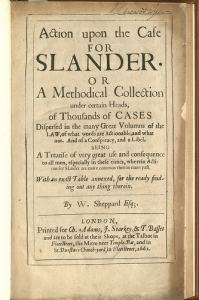
By Greg Berman
Controversy erupted last week after a George Washington University professor, Dave Karpf, tweeted a joke at New York Times columnist Bret Stephens’s expense. Quoting an 8-word post about a bedbug infestation in the Times’ newsroom, Karpf joked that “[t]he bedbugs are a metaphor. The bedbugs are Bret Stephens.”[1] Although this tweet did not initially gain much traction, it later went viral when Stephens personally emailed Karpf, as well as the George Washington University provost, demanding an apology for the insult.[2] After several more tweets and an off-scheduled column post by Stephens with visible references to the controversy, both sides of the feud seem to be slowing down.[3] Although this back and forth is just one isolated incident between two individuals, it highlights a growing trend in our discourse. With the growing usage of social media in our society, these sorts of ideological clashes have seemingly become more prevalent than ever.[4] And even though these virtual arguments tend to be more of an annoyance than a liability, reputation-damaging attacks (even those made on the internet) still can run the risk of triggering a costly libel lawsuit.[5]
The tort of libel is defined by Black’s Law Dictionary as “[a] defamatory statement expressed in a fixed medium, esp[ecially] writing but also a picture, sign, or electronic broadcast.”[6] The enforcement of libel laws in the United States dates predates the ratification of the Constitution, most notably with the trial of John Peter Zenger, whose 1735 jury acquittal established the idea that someone cannot be charged with libel if the remark is true.[7] Even today, the accuracy of the allegedly libelous statements continues to be one of key factors for courts to consider in libel cases, with each state setting their own standards for liability.[8] Another key consideration for courts comes from New York Times v. Sullivan, where the Supreme Court differentiated defamation claims involving public figures and private individuals, holding that any libel suit against a public figure requires the inaccurate statement to be made with “actual malice.”[9] Actual malice has been defined by the Court as “knowledge that (the statement) was false or with reckless disregard of whether it was false or not.”[10] Additional protections against libel claims were enacted nine years later, when the Supreme Court limited libel laws to apply only to intentionally false statements of fact, even if a trial court is presented with baseless opinions that are similarly incorrect.[11]
Our ever-increasing move toward a digitalized world raises the question of how these libel laws can be applied to internet publications. To start, no claim for libel can be made against any social media site, such as Facebook or Twitter, for content posted by a user of that social media site.[12] This is primarily due to the expansive legal protections given to these “interactive computer services” by Section 230 of the Communications Decency Act of 1996.[13] That being said, individuals may still be held liable for content that they post on the internet, with each state continuing to apply its own standards for libelous conduct even as information crosses state lines.[14] When it comes to the question of jurisdiction, the Supreme Court clarified in Keeton v. Hustler Magazine, Inc. that a state can claim jurisdiction over a non-resident when injurious information is intentionally disseminated to its citizens.[15] Specifically, the Court cited each state’s interest in protecting its citizens from intentional falsehoods as a key consideration in its decision.[16] While online information is disseminated in a different manner than the magazines from Keeton, courts have begun allow jurisdiction for internet libel cases when the online post directly targets one or more residents of the state.[17]
When applying libel laws to online statements, courts have used similar substantive principles to those used for print publications. In 2009, former musician Courtney Love was sued by her former attorney after tweeting allegedly libelous remarks.[18] As this was the first reported case to go to a jury decision for remarks made over Twitter, the trial court was left with a case of first impression.[19] In a landmark decision, the court opted to apply traditional libel laws. A jury found that Love did not know that the statements were false at the time they were made; she therefore lacked the actual malice required to be considered libel.[20]
There have also been other cases involving libelous comments made over Twitter.[21] For example, one such case took place after a tenant complained on her personal Twitter account about her “moldy apartment.”[22] After seeing the post, the landlord sued the tenant under Illinois libel laws; the case was later dismissed with prejudice because the tweet was too vague to meet the requisite legal standards for libel.[23] Another lawsuit took place after a mid-game conversation between an NBA coach and a referee was overheard and tweeted out by an AP reporter.[24] The referee insisted that the reported conversation never took place, and the subsequent lawsuit ultimately resulted in a $20,000 settlement.[25] Each of these cases present factually unique scenarios, but all together indicate a growing trend: even as the medium for public discourse has been rapidly shifting towards the digital sphere, traditional libel laws still continue to apply.
In addition to substantive treatment, there also remain unresolved legal questions stemming from courts’ application of the single publication rule. The single publication rule provides that “any one edition of a book or newspaper, or any one radio or television broadcast, exhibition of a motion picture or similar aggregate communication is a single publication” and therefore “only one action for damages can be maintained.”[26] The justification behind this rule is simple: by aggregating all damages allegedly caused by a publication to a single action, a party would not be perpetually bombarded with litigation long after their active role in publication has ended.[27] This rule has already been adopted in “the great majority of states” and was implemented within the 4th Circuit in Morrissey v. William Morrow & Co.[28] However, some academics have proposed that the single publication rule should not always be applied to social media posts, citing the possibility that a publisher could personally solicit shares or retweets and thereby maintain an active role in republishing libelous information.[29] The issue of continual dissemination by means of retweeting seems primed to be raised in later litigation, but thus far has not been brought before any court.[30] Still, many circuits have already begun the process of implementing the single publication rule to online posts in general (so far these cases have been litigated over personal blogs rather than Facebook or Twitter posts), so it will be interesting to see how courts handle the issue if eventually raised by litigants down the road.[31]
As
the social media presence in our society grows stronger each day, only time
will tell if courts will craft separate libel principles for online publications.
There are arguments to be made on both
sides, especially now that online mediums are increasingly taking over many of the
informational functions previously held by their print counterparts.[32] For now, at least, courts are continuing to
use the same traditional libel laws that have been evolving and changing since John
Peter Zenger’s 1735 acquittal. [33]
And while the jury is still out on
whether Dave Karpf actually thinks Bret Stephens is a metaphorical bedbug, he
can likely rest easy knowing that current libel laws will protect his joke from
any future legal trouble.
1. Dave Korpf (@davekorpf), Twitter (Aug. 26, 2019, 5:07 PM), https://twitter.com/davekarpf/status/1166094950024515584.
[2] See Dave Korpf (@davekorpf), Twitter (Aug. 26, 2019, 9:22 PM), https://twitter.com/davekarpf/status/1166159027589570566; Dave Korpf (@davekorpf), Twitter (Aug. 26, 2019, 10:13 PM) https://twitter.com/davekarpf/status/1166171837082079232; see also Tim Efrink & Morgan Krakow, A Professor Called Bret Stephens a ‘Bedbug.’ The New York Times Columnist Complained to the Professor’s Boss, Wash. Post (Aug. 27, 2019), https://www.washingtonpost.com/nation/2019/08/27/bret-stephens-bedbug-david-karpf-twitter/ (summarizing the context of Korpf’s tweet and the resulting controversy).
[3] See Dave Korpf (@davekorpf), Twitter (Aug. 30, 2019, 7:58 PM), https://twitter.com/davekarpf/status/1167587392292892672; Bret Stephens, Opinion, World War II and the Ingredients of Slaughter, N.Y. Times (Aug. 30, 2019), https://www.nytimes.com/2019/08/30/opinion/world-war-ii-anniversary.html.
[4] Jasmine Garsd, In An Increasingly Polarized America, Is It Possible To Be Civil On Social Media?, NPR (Mar. 31, 2019) https://www.npr.org/2019/03/31/708039892/in-an-increasingly-polarized-america-is-it-possible-to-be-civil-on-social-media.
[5] See id.; Adeline A. Allen, Twibel Retweeted: Twitter Libel and the Single Publication Rule,15 J. High Tech. L. 63, 81 n.99 (2014).
[6] Libel, Black’s Law Dictionary (11th ed. 2019).
[7] Michael Kent Curtis, J. Wilson Parker, William G. Ross, Davison M. Douglas & Paul Finkelman, Constitutional Law in Context 1038 (4th ed. 2018).
[8] James L. Pielemeier, Constitutional Limitations on Choice of Law: The Special Case of Multistate Defamation, 133 U. Pa. L. Rev. 381, 384 (1985).
[9] 376 U.S. 254, 279–80 (1964); see also Gertz v. Robert Welch, Inc., 418 U.S. 323, 351 (1974) (defining a public figure as either “an individual achiev[ing] such pervasive fame or notoriety” or an individual who “voluntarily injects himself or is drawn into a particular public controversy”).
[10] Sullivan, 376 U.S. at 280.
[11] See Gertz, 418 U.S. at 339 (“[u]nder the First Amendment, there is no such thing as a false idea.”).
[12] See Allen, supra note 5, at 82. Of course, Facebook and Twitter are not immunized against suits for content that they post on their own platforms. Cf. Force v. Facebook, Inc., ___ F.3d ___, No. 18-397, 2019 WL 3432818, slip op. at 41 (2d Cir. July 31, 2019), http://www.ca2.uscourts.gov/decisions/isysquery/a9011811-1969-4f97-bef7-7eb025d7d66c/1/doc/18-397_complete_opn.pdf (“If Facebook was a creator or developer, even ‘in part,’ of the terrorism-related content upon which plaintiffs’ claims rely, then Facebook is an ‘information content provider’ of that content and is not protected by Section 230(c)(1) immunity.”).
[13] 47 U.S.C. §230(c)(1) (2017) (“No provider or user of an interactive computer service shall be treated as the publisher or speaker of any information provided by another information content provider.”). “Interactive computer service” is defined by the act as “any information service, system, or access software provider that provides or enables computer access by multiple users to a computer server”). Id. at §230(f)(2); see also Allen, supra note 5, at 82 n.100 (describing additional protections provided by the Communications Decency Act, including how Twitter falls under its definition of “interactive computer service”).
[14] See Allen, supra note 5, at 84; Pielemeier, supra note 8, at 384.
[15] 465 U.S. 770, 777 (1984); see also Calder v. Jones, 465 U.S. 783, 791 (1984) (holding that personal jurisdiction is proper over defendants who purposefully directed libelous information at the plaintiff’s home state with the intent of causing harm).
[16] Keeton, 465 U.S. at 777.
[17] See, e.g.,Zippo Mfg. Co. v. Zippo Dot Com, Inc., 952 F. Supp. 1119, 1124 (W.D. Pa. 1997); Young v. New Haven Advocate, 315 F.3d 256, 263 (4th Cir. 2002); Tamburo v. Dworkin, 601 F.3d 693, 707 (7th Cir. 2010) (each applying traditional libel tests for personal jurisdiction to online publications, requiring the publication to be intentionally targeted towards citizens of the state).
[18] Gordon v. Love, No. B256367, 2016 WL 374950, at *2 (Cal. Ct. App. Feb. 1, 2016). The exact language of the tweet in question was “I was fucking devastated when Rhonda J. Holmes, Esquire, of San Diego was bought off @FairNewsSpears perhaps you can get a quote.” Id. The tweet was deleted five to seven minutes after it was posted. Id. at *3. This was Love’s second time being sued for defamation over comments made on her Twitter account, although the first lawsuit resulted in a $430,000 settlement before trial. Matthew Belloni, Courtney Love to Pay $430,000 in Twitter Case, Reuters (Mar. 3, 2011), https://www.reuters.com/article/us-courtneylove/courtney-love-to-pay-430000-in-twitter-case-idUSTRE7230F820110304.
[19] See Allen, supra note 5, at 81 n.99.
[20] Love, 2016 WL 374950, at *3. The reason actual malice was required in the case is because Love’s attorney had gained public figure status, which was not disputed at trial. Id.
[21] See Joe Trevino, From Tweets to Twibel*: Why the Current Defamation Law Does Not Provide for Jay Cutler’s Feelings, 19 Sports Law J. 49, 61–63 (2012) (describing a series of libel lawsuits stemming from social media posts).
[22] Id. at 61.
[23] Andrew L. Wang, Twitter Apartment Mold Libel Suit Dismissed, Chi. Trib. (Jan. 22, 2010), https://www.chicagotribune.com/news/ct-xpm-2010-01-22-1001210830-story.html.
[24] Trevino, supra note 21, at 63.
[25] Lauren Dugan, The AP Settles Over NBA Twitter Lawsuit, Pays $20,000 Fine, Adweek (Dec. 8, 2011), https://www.adweek.com/digital/the-ap-settles-over-nba-twitter-lawsuit-pays-20000-fine/.
[26] Restatement (Second) of Torts § 577A(3–4) (Am. Law Inst. 1977).
[27] Id. at § 577A cmt. b.
[28] 739 F.2d 962, 967 (4th Cir. 1984) (quoting Keeton, 465 U.S. at 777 n.8).
[29] Allen, supra note 5, at 87–88.
[30] See Lori A. Wood, Cyber-Defamation and the Single Publication Rule, 81 B.U. L. Rev. 895, 915 (2001) (calling for courts to define “republication” in the context of internet publications).
[31] See, e.g., Firth v. State, 775 N.E.2d 463, 466 (N.Y. 2002); Van Buskirk v. N.Y. Times Co., 325 F.3d 87, 90 (2d Cir. 2003); Oja v. U.S. Army Corps of Eng’rs, 440 F.3d 1122, 1130–31 (9th Cir. 2006); Nationwide Bi-Weekly Admin., Inc. v. Belo Corp., 512 F.3d 137, 144 (5th Cir. 2007). But see Swafford v. Memphis Individual Prac. Ass’n, 1998 Tenn. App. LEXIS 361, at *38 (Tenn. App. 1998).
[32] See Allen, supra note 5, at 91 n.157.
[33] See Trevino, supra note 19, at 69.





